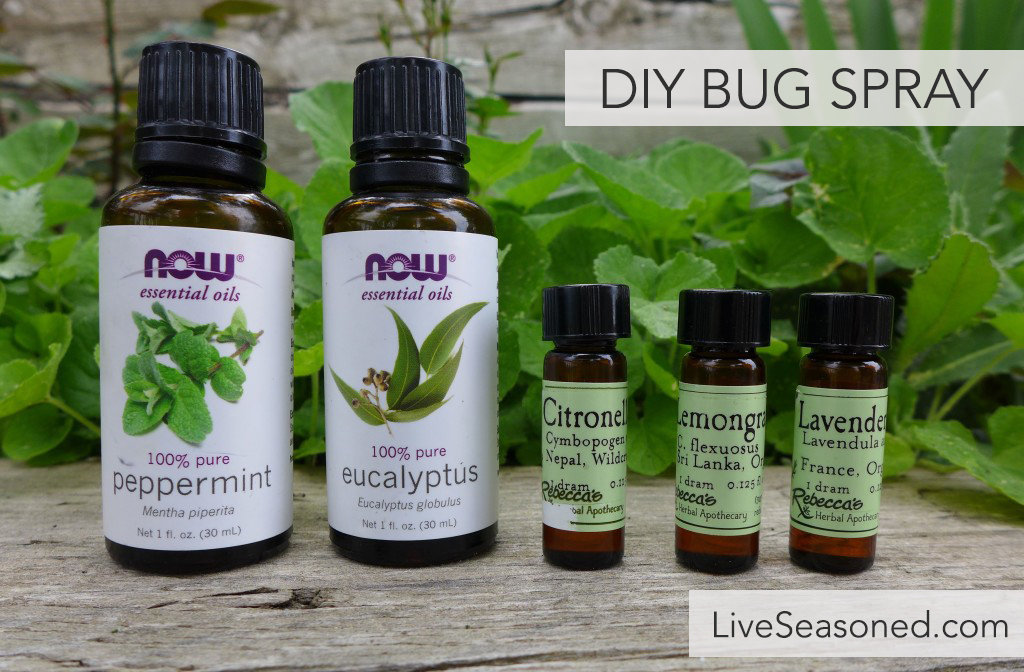This is part of our ongoing series on using essential oils for home and body care. You can see our archive of essential oil posts here.
We’re celebrating Pollinator Week around here with a series of pollinator-related posts. When you grab a bottle of bug spray, I’m guessing that “pollinator” is not the first word that you think of, instead, it’s likely “mosquito” “f-ing mosquitos”. Am I right? But guess, what?! Mosquitos are pollinators!
Pollination aside, we will never grow to love the pesky mosquitos, ticks, and fleas. Today we’re sharing a natural, non-toxic bug spray. I find that this works well when the mosquito populations aren’t too high, but I admit, there are still times, particularly in the swampy waters at the shore, that I have to use something containing DEET. What this spray lacks in DEET, it makes up for in its beautiful scent, and in the ability to personalize (there are so many mixing options below!).
The Science of Biting Insects
Mosquitoes are attracted to the carbon dioxide released as we breath as well as natural odors on our skin, including cholesterol, steroids, and certain acid compounds. Side note : you don’t have to have high cholesterol to excrete a high concentration of cholesterol compounds on your skin. This does mean that mosquitoes will be more attracted to people who happen to have more of those compounds on their skin.
Mosquito repellants work by filling the insect’s sensors with scent compounds that confuse the insect, making it unable to land on its target. Some repellants, like DEET, are better at jamming the insects’ sensors than others and they last for a longer period of time on the skin.
Make your spray.
A good natural bug spray should contain essential oils that are known insect repellants diluted in a base liquid that won’t irritate your skin and/or stain your clothes. We make two versions of this spray containing the same essential oils, but with two different bases. For the bug spray that will be applied directly to our skin, we like to use an oil base, but for a bug spray that we’re going to apply to our clothes, tent, and other fabrics, we like to use a water base.
Common base liquids for bug spray:
- olive oil
- almond oil
- jojoba oil
- witch hazel (this may be drying/irritating to some skin, you can mix it half and half with aloe vera or water)
- aloe vera
- vodka
- distilled water
Common essential oils known to deter biting insects:
- Peppermint (ants and fleas)
- Lemongrass (mosquitos and fleas)
- Citronella (mosquitos and deer flies)
- Lavender (fleas)
- Eucalyptus (mosquitos, ticks, and lice)
Mixing Tips:
- Start with a 4 oz spray bottle.
- Add a combination of the essential oils above for a total of 30-50 drops. I recommend using a combination of the essential oils listed above to maximize the spray’s effectiveness. For example, I may make a spray that contains 15 drops each of lemongrass and citronella plus 10 drops each of peppermint and eucalyptus.
- Fill the bottle nearly to the top with a base liquid then shake well and spray!
Unfortunately, I’ve found that these natural sprays are not as long-lasting as commercial chemical sprays. All that means is that I have to reapply the spray more often, but the frequency varies depending upon how often I’m getting attacks and what I’m doing. If I’m on a brisk hike in an open area, the bugs may not be as bad as they are if I’m sitting in a shady humid area, so I may reapply the bug spray a lot more often in the second location than in the first.
Always remember to keep the essential oils out of your eyes. It’s often best to spray the bug spray into your hands and then rub it on your face, hair, and neck, rather than spraying it directly onto your head.
And that’s it, a super simple recipe to keep the bugs at bay. Give it a try and let us know how it works for you!
Image sources : Mosquito on flower, Mosquito on skin




